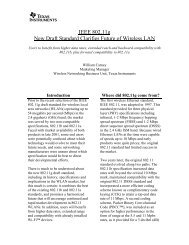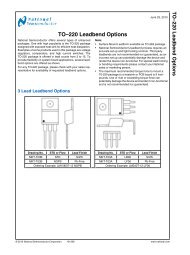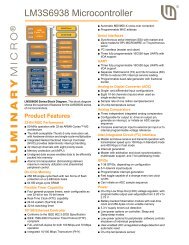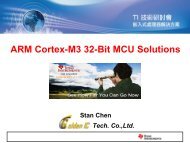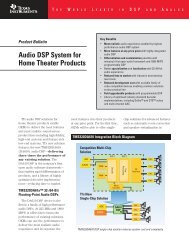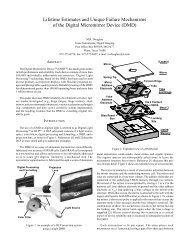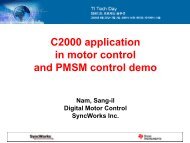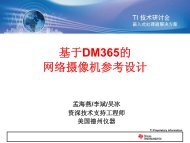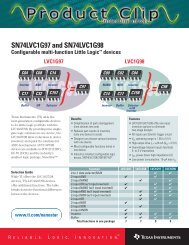DSP Implementation of an Improved DTC Technique for Induction ...
DSP Implementation of an Improved DTC Technique for Induction ...
DSP Implementation of an Improved DTC Technique for Induction ...
Create successful ePaper yourself
Turn your PDF publications into a flip-book with our unique Google optimized e-Paper software.
switching Table 1, dψ = 1 <strong>an</strong>d dψ = 0 indicates the stator flux needs to be increased <strong>an</strong>d reduced respectively.<br />
Similarly, dT = 1 indicates the motor torque needs to be increased, <strong>an</strong>d dT = 0 <strong>an</strong>d dT = -1 indicate the torque needs<br />
to be reduced slowly <strong>an</strong>d quickly respectively. Speed control is achieved using a PI controller. In a <strong>DTC</strong> drive, as<br />
shown in Figure 1, the torque reference is also obtained from the PI speed controller.<br />
Table 1 Stator Voltage Switching Table.<br />
<strong>Induction</strong> Motor Model in the Stationary Reference Frame<br />
The stationary reference frame induction motor model, with stator <strong>an</strong>d rotor fluxes as state variables, is defined by<br />
equation (1) <strong>an</strong>d <strong>for</strong>ms the basis <strong>for</strong> the simulation results in this paper.<br />
d<br />
dt<br />
⎡<br />
⎢<br />
⎣<br />
s<br />
r<br />
⎡ Rs<br />
⎢ −<br />
⎤<br />
⎢<br />
s<br />
⎥ =<br />
⎦ ⎢ Rr<br />
M<br />
⎢<br />
⎣ s<br />
Lr<br />
Rs<br />
M ⎤<br />
⎥<br />
s<br />
Lr<br />
⎥<br />
⎡<br />
⎛ R ⎢<br />
r ⎞⎥<br />
j ⎣<br />
⎜ r −<br />
⎟<br />
⎟⎥<br />
⎝<br />
r ⎠⎦<br />
s<br />
r<br />
⎤ ⎡1⎤<br />
⎥ + ⎢ ⎥V<br />
⎦ ⎣0⎦<br />
where s <strong>an</strong>d r are stator <strong>an</strong>d rotor flux space vectors, s V is stator voltage space vector, s R <strong>an</strong>d R r are the<br />
stator <strong>an</strong>d rotor resist<strong>an</strong>ces, L s <strong>an</strong>d L r are stator <strong>an</strong>d rotor self-induct<strong>an</strong>ces, M is the mutual induct<strong>an</strong>ce,<br />
2<br />
= 1 - M Ls<br />
Lr<br />
is the leakage coefficient <strong>an</strong>d r<br />
calculated from equations (2) <strong>an</strong>d (3) respectively.<br />
i<br />
i<br />
ds<br />
qs<br />
2<br />
s<br />
is rotor <strong>an</strong>gular speed. Stator dq current components are<br />
ds − md<br />
= (2)<br />
L − M<br />
s<br />
qs − mq<br />
= (3)<br />
L − M<br />
s<br />
X aq X aq<br />
X aq X aq<br />
where, md = ds +<br />
dr , mq =<br />
qs +<br />
qr<br />
L − M L − M<br />
L − M L − M<br />
s<br />
<strong>an</strong>d [ ] 1 −<br />
X = ( 1/M + 1/ ( L − M ) + 1/ ( L − M ) .<br />
aq<br />
dψ dT N1 N2 N3 N4 N5 N6<br />
1 V2(110) V3(010) V4(011) V5(001) V6(101) V1(100)<br />
1 0 V7(111) V0(000) V7(111) V0(000) V7(111) V0(000)<br />
-1 V6(101) V1(100) V2(110) V3(010) V4(011) V5(001)<br />
1 V3(010) V4(011) V5(001) V6(101) V1(100) V2(110)<br />
0 0 V0(000) V7(111) V0(000) V7(111) V0(000) V7(111)<br />
-1 V5(001) V6(101) V1(100) V2(110) V3(010) V4(011)<br />
s<br />
r<br />
r<br />
s<br />
The electromagnetic torque c<strong>an</strong> be expressed in terms <strong>of</strong> stator flux <strong>an</strong>d current as shown in equation (4)<br />
( i i )<br />
⎛ 3 ⎞⎛<br />
P ⎞<br />
Te = ⎜ ⎟⎜<br />
⎟ ds qs −<br />
⎝ 2 ⎠⎝<br />
2 ⎠<br />
qs ds<br />
where P is the number <strong>of</strong> poles in the induction motor.<br />
Compensation <strong>of</strong> the Effect <strong>of</strong> the Stator Voltage-Drop<br />
A major problem in the application <strong>of</strong> <strong>DTC</strong> at low motor speed is the effect <strong>of</strong> the IsRs voltage drop. In order to<br />
improve flux control at low speed, optimum switching vector selection <strong>an</strong>d a technique that eliminates the effects<br />
<strong>of</strong> the IsRs voltage drop in the machine stator is there<strong>for</strong>e considered.<br />
Figure 2 shows the switching voltage space vectors <strong>an</strong>d stator resist<strong>an</strong>ce voltage drop. It c<strong>an</strong> be seen that at high<br />
speed, the amplitude <strong>of</strong> the stator voltage vector sh V is large <strong>an</strong>d the voltage drop across R s is relatively small <strong>an</strong>d<br />
c<strong>an</strong> be neglected, as shown in Figure 2(a). However, it c<strong>an</strong> be seen from Figure 2(b) that, at low speed, the voltage<br />
drop across s R may be the major portion <strong>of</strong> measured terminal voltage V sl . Moreover, as the temperature <strong>of</strong> the<br />
r<br />
(1)<br />
(4)



